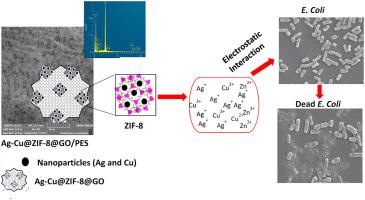当前位置:
X-MOL 学术
›
J. Membr. Sci.
›
论文详情
Our official English website, www.x-mol.net, welcomes your feedback! (Note: you will need to create a separate account there.)
Incorporation of a novel Ag–Cu@ZIF-8@GO nanocomposite into polyethersulfone membrane for fouling and bacterial resistance
Journal of Membrane Science ( IF 9.5 ) Pub Date : 2021-01-01 , DOI: 10.1016/j.memsci.2020.118733 T.A. Makhetha , R.M. Moutloali
Journal of Membrane Science ( IF 9.5 ) Pub Date : 2021-01-01 , DOI: 10.1016/j.memsci.2020.118733 T.A. Makhetha , R.M. Moutloali

|
Abstract A series of nanocomposite membranes, Ag@ZIF-8@GO/PES, Cu@ZIF-8@GO/PES and Ag–Cu@ZIF-8@GO/PES, were fabricated via phase inversion method. These were characterized using scanning electron microscopy (SEM) coupled with energy dispersive X-ray (EDS), X-ray photoelectron microscopy (XPS), atomic force microscopy (AFM) and water contact angle (WCA) measurements. The SEM images revealed an increase in pore density with the incorporation of the hydrophilic GO, porous ZIF-8 and the ZIF-8@GO composite as well as those containing Ag and Cu. The presence and the distribution of the nanoparticles onto the membranes were confirmed by XPS, EDS and elemental mapping. The composite membranes containing AgNPs showed excellent antibacterial properties against Escherichia coli. Furthermore, the antifouling properties of the composite membranes were assessed by filtration of bovine serum albumin (BSA), as a model foulant. An increased flux recovery ratio for the composite membranes (78–97%) was observed in comparison to that of the pristine PES membrane (43%). The flux recovery ratios of the nanocomposite membranes were maintained for more than six cycles showing their recyclability and fouling resistance. The observed metal leaching from the composite membranes was minimal and far less than the WHO threshold. The incorporation of the composite fillers led to concurrent improvement in the bacterial growth inhibition and protein fouling resistance boding well for application in water treatment.
中文翻译:

将新型 Ag-Cu@ZIF-8@GO 纳米复合材料掺入聚醚砜膜中以抗污染和抗细菌
摘要 采用相转化法制备了一系列纳米复合膜Ag@ZIF-8@GO/PES、Cu@ZIF-8@GO/PES和Ag-Cu@ZIF-8@GO/PES。使用扫描电子显微镜 (SEM) 结合能量色散 X 射线 (EDS)、X 射线光电子显微镜 (XPS)、原子力显微镜 (AFM) 和水接触角 (WCA) 测量对这些进行表征。SEM 图像显示,随着亲水性 GO、多孔 ZIF-8 和 ZIF-8@GO 复合材料以及含有银和铜的复合材料的加入,孔密度增加。通过 XPS、EDS 和元素映射证实了纳米颗粒在膜上的存在和分布。含有AgNPs的复合膜对大肠杆菌表现出优异的抗菌性能。此外,通过过滤牛血清白蛋白 (BSA) 作为模型污垢来评估复合膜的防污性能。与原始 PES 膜 (43%) 相比,观察到复合膜的通量回收率增加 (78-97%)。纳米复合膜的通量回收率保持超过六个循环,显示了它们的可回收性和抗污染性。从复合膜中观察到的金属浸出量很小,远低于 WHO 阈值。复合填料的掺入导致细菌生长抑制和蛋白质污染抗性的同时改善,预示着在水处理中的应用很好。与原始 PES 膜 (43%) 相比,观察到复合膜的通量回收率增加 (78-97%)。纳米复合膜的通量回收率保持超过六个循环,显示了它们的可回收性和抗污染性。从复合膜中观察到的金属浸出量很小,远低于 WHO 阈值。复合填料的掺入导致细菌生长抑制和蛋白质污染抗性的同时改善,预示着在水处理中的应用很好。与原始 PES 膜 (43%) 相比,观察到复合膜的通量回收率增加 (78-97%)。纳米复合膜的通量回收率保持超过六个循环,显示了它们的可回收性和抗污染性。从复合膜中观察到的金属浸出量很小,远低于 WHO 阈值。复合填料的掺入导致细菌生长抑制和蛋白质污染抗性的同时改善,预示着在水处理中的应用很好。从复合膜中观察到的金属浸出量很小,远低于 WHO 阈值。复合填料的掺入导致细菌生长抑制和蛋白质污染抗性的同时改善,预示着在水处理中的应用很好。从复合膜中观察到的金属浸出量很小,远低于 WHO 阈值。复合填料的掺入导致细菌生长抑制和蛋白质污染抗性的同时改善,预示着在水处理中的应用很好。
更新日期:2021-01-01
中文翻译:

将新型 Ag-Cu@ZIF-8@GO 纳米复合材料掺入聚醚砜膜中以抗污染和抗细菌
摘要 采用相转化法制备了一系列纳米复合膜Ag@ZIF-8@GO/PES、Cu@ZIF-8@GO/PES和Ag-Cu@ZIF-8@GO/PES。使用扫描电子显微镜 (SEM) 结合能量色散 X 射线 (EDS)、X 射线光电子显微镜 (XPS)、原子力显微镜 (AFM) 和水接触角 (WCA) 测量对这些进行表征。SEM 图像显示,随着亲水性 GO、多孔 ZIF-8 和 ZIF-8@GO 复合材料以及含有银和铜的复合材料的加入,孔密度增加。通过 XPS、EDS 和元素映射证实了纳米颗粒在膜上的存在和分布。含有AgNPs的复合膜对大肠杆菌表现出优异的抗菌性能。此外,通过过滤牛血清白蛋白 (BSA) 作为模型污垢来评估复合膜的防污性能。与原始 PES 膜 (43%) 相比,观察到复合膜的通量回收率增加 (78-97%)。纳米复合膜的通量回收率保持超过六个循环,显示了它们的可回收性和抗污染性。从复合膜中观察到的金属浸出量很小,远低于 WHO 阈值。复合填料的掺入导致细菌生长抑制和蛋白质污染抗性的同时改善,预示着在水处理中的应用很好。与原始 PES 膜 (43%) 相比,观察到复合膜的通量回收率增加 (78-97%)。纳米复合膜的通量回收率保持超过六个循环,显示了它们的可回收性和抗污染性。从复合膜中观察到的金属浸出量很小,远低于 WHO 阈值。复合填料的掺入导致细菌生长抑制和蛋白质污染抗性的同时改善,预示着在水处理中的应用很好。与原始 PES 膜 (43%) 相比,观察到复合膜的通量回收率增加 (78-97%)。纳米复合膜的通量回收率保持超过六个循环,显示了它们的可回收性和抗污染性。从复合膜中观察到的金属浸出量很小,远低于 WHO 阈值。复合填料的掺入导致细菌生长抑制和蛋白质污染抗性的同时改善,预示着在水处理中的应用很好。从复合膜中观察到的金属浸出量很小,远低于 WHO 阈值。复合填料的掺入导致细菌生长抑制和蛋白质污染抗性的同时改善,预示着在水处理中的应用很好。从复合膜中观察到的金属浸出量很小,远低于 WHO 阈值。复合填料的掺入导致细菌生长抑制和蛋白质污染抗性的同时改善,预示着在水处理中的应用很好。


























 京公网安备 11010802027423号
京公网安备 11010802027423号